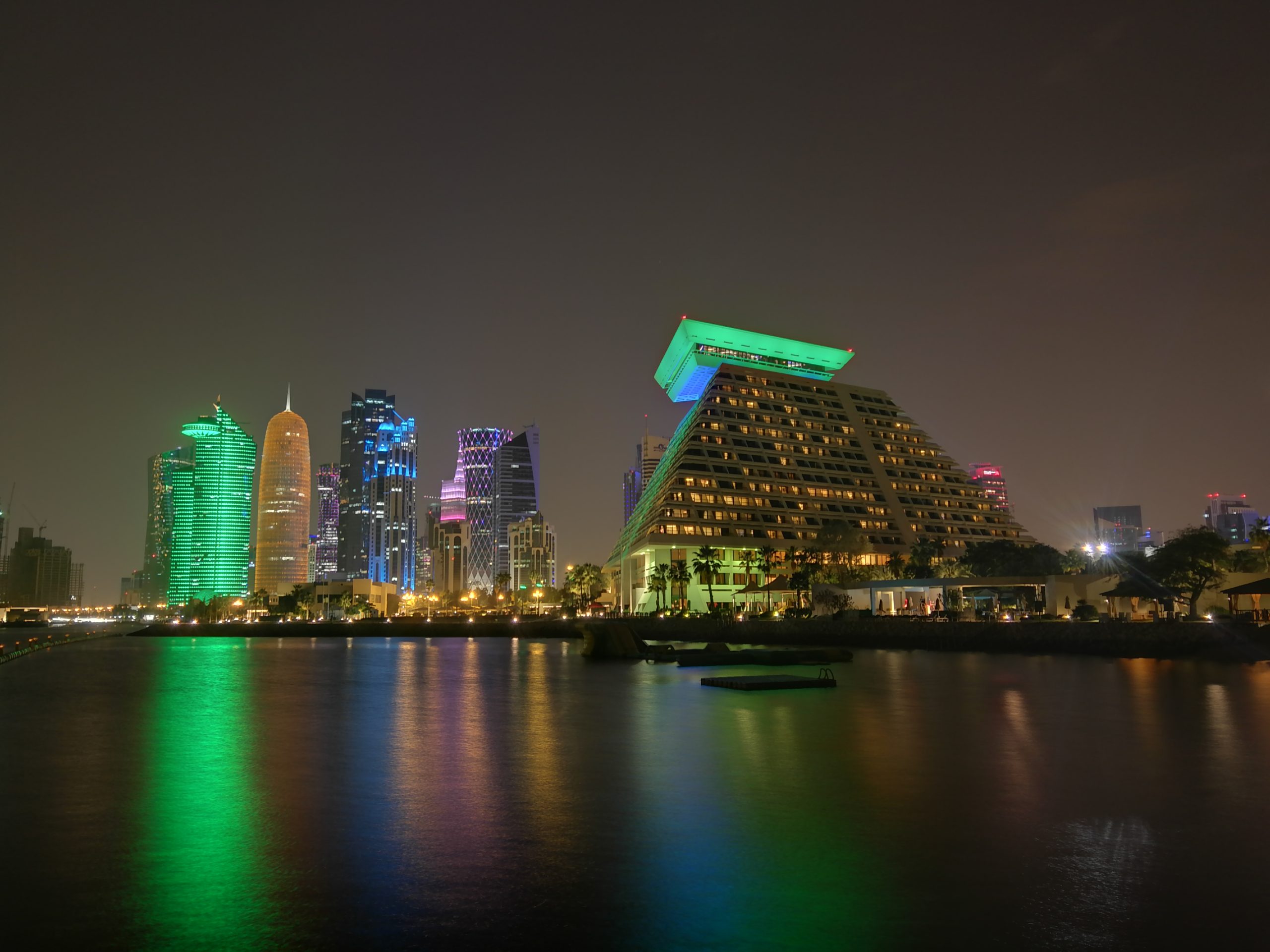14 North Africa & the Middle East: Economic Geography I – Oil
“Control over the production and distribution of oil is the decisive factor in defining who rules whom in the Middle East.”
- Christopher Hitchens, author
If most Americans were asked to guess the leading export of any country in the North Africa and Southwest Asia, nearly all of them would likely have the same answer: oil. And they would have good reasons for that answer. Of the world’s ten leading oil-producing countries, four of them are located in the Middle East. And of the ten countries with the largest reserves of oil, six are located in the Middle East and North Africa. More to the point, oil accounts for more than half of the export revenues in eleven of the region’s countries, and for more than 90% of export revenues in four of them. Only six countries in the region – Tunisia, Turkey, Israel, Jordan, Morocco, and Lebanon – receive less than 30% of the export revenues from oil. The table below shows the importance of oil to the regional economy.
| Country | Daily Production (000s of barrels) | Oil (millions of barrels) | Oil as Percentage of Export Revenue |
|---|---|---|---|
| Saudi Arabia | 9,313 | 258,600 | 68% |
| Iraq | 4,084 | 145,019 | 100% |
| UAE | 3,091 | 97,800 | 71% |
| Kuwait | 2,527 | 101,500 | 93% |
| Qatar | 1,303 | 25,244 | 82% |
| Libya | 1,237 | 48,363 | 95% |
| Algeria | 1,133 | 12,200 | 96% |
| Oman | 970 | 5,373 | 75% |
| Iran | 610 | 208,600 | 69% |
| Egypt | 560 | 3,300 | 32% |
| Bahrain | 174 | 186 | 42% |
| Yemen | 70 | 3,000 | 85% |
| Sudan | 66 | 5,000 | 82% |
| Turkey | 66 | 366 | 4% |
| Tunisia | 35 | 425 | 8% |
| Syria | 34 | 2,500 | 50% |
| Israel | 6 | 12 | 2% |
| Jordan | 0.4 | 1 | 1% |
| Morocco | 0.1 | 0.6 | 1% |
| Lebanon | 0 | 0 | 0% |
Beginnings of the Oil Industry
Western exploration for oil in North Africa and the Middle East dates to the early 1900s. A number of industrial powers in Europe were looking to make a transition from coal to petroleum as a primary energy source for their industrial economies, particularly in transportation. Vast oil fields were discovered in the Sahara, and even larger ones near the Persian Gulf, but for years these areas remained relatively marginal to global oil markets. Oil production in Europe and the Americas was sufficient to meet the needs of the world’s industrialized countries. During and after World War II, however, global demand for oil accelerated dramatically, and the region was catapulted to economic prominence.

At the time, some of the region’s biggest oil reserves were in poor, rural, and sparsely populated countries. Few people in these oil-rich states had any expertise when it came producing or transporting oil, so they turned to Western oil companies. Over time, European companies such as British Petroleum and Royal Dutch Shell, and American companies like SoCal, Esso, Texaco, Gulf, and Socony came to dominate the region’s oil exploration, production, and transportation.
These Western companies would rent a piece of land, and were given rights to whatever oil might be discovered there for the duration of their lease. These companies paid for the leases, of course, along with property and export taxes, but otherwise they reaped almost all of the profits from the oil they extracted. Revenues from the leases and taxes were considerable, and the region’s governments and economic elite became quite wealthy as a result. Still, an increasing number of countries in the region began to feel that they were being exploited by the foreign oil companies, and moved to keep a larger share of the profits for themselves.
Nationalization
Nationalization is a process in which a government assumes control of a private industry. In the oil industry, nationalization means that all of the oil in a country becomes property of the government, and all revenues from its sale go to the government. Iraq and Egypt nationalized their oil reserves in the 1960s. By the mid-1970s, virtually every major oil field in North Africa and the Middle East had been nationalized. Western oil companies still played a vital role in transporting, refining, marketing, and distributing the region’s oil, but governments would now reap a much larger share of the economic benefits.
These governments also moved to increase revenue by raising prices. In the early 1960s, many of the region’s major oil exporters formed the Organization of Petroleum Exporting Countries (OPEC). The organization’s primary function is based on a fundamental law of economics – if the supply of a commodity increases, its value decreases. OPEC countries wanted to sell as much oil as possible, of course, but if they produced oil at maximum capacity, it flooded global markets and drove down prices and profits. If OPEC reduced production, then prices would rise. OPEC’s goal was to set production quotas for each member, seeking an equilibrium that kept production and prices at levels that were the most profitable.
Both nationalization and the formation of OPEC created a huge financial windfall for the region’s oil producers. In the early 1970s, Saudi Arabia’s annual oil revenues were about $2.7 billion. In the early 1980s, its annual oil revenues had skyrocketed to $110 billion.
Diversification
Unfortunately for North Africa and the Middle East’s oil-rich states, the industry will inevitably decline. Oil is a fossil fuel. It takes millions of years to create oil, so from the human perspective, once oil is gone, it’s gone. If oil continues to be pumped at current rates, Kuwait’s reserves will run out in about a century, and Saudi Arabia, Iraq, the UAE will run out before that. Qatar, Tunisia, and Algeria have the less than fifty years of oil left, and the oil fields of Oman, Egypt, Yemen, Bahrain, and Morocco will be drained in less than twenty years. Syria, Libya, and Iran each have more than two centuries of oil reserves left at current production rates, but that’s because their current production has been drastically reduced by conflict or economic sanctions. If they return to peak production, they will run out of oil much faster than that.
This is not news. Oil-dependent countries have always known that their wells will eventually run dry. But the race against the clock has recently sped up because of a new challenge – alternative energy. Driven by concerns about climate change, air pollution, and the political instability of many oil-producing countries, most of the world’s major oil consumers are investing heavily in alternative sources of power generation, such as wind, geothermal, and solar. They are also attempting to replace petroleum-fueled transportation with electric vehicles. These renewable energy sources are becoming more reliable and much cheaper, as are batteries to store the energy they produce. It is likely that renewable energy sources will pass fossil fuels as the primary source of energy on the planet within the next two decades, and possibly much sooner. What had been a 100-year problem for many oil-producing countries has suddenly become a twenty-year problem.

The countries that have made the greatest strides in preparing for a post-oil world are located along the Persian Gulf – Bahrain, Kuwait, Oman, Qatar, Saudi Arabia, and the UAE. They have all built modern cities with state-of-the-art infrastructure. They have all seen significant growth in the tourism, banking, finance, and transportation, and have created a business-friendly environment, featuring low taxes, loose regulations, and free-trade zones. They have created economic incubators that provide subsidies to small-scale, high-tech start-ups. They have transformed their educational institutions to train young nationals for a post-oil, knowledge-based economy, and are trying to lure skilled workers and entrepreneurs from South and Southeast Asia. Dubai, the UAE’s leading city, has been particularly successful in these pursuits, and has transformed itself into a global financial, business, and transportation hub.
Still, even the pro-active Gulf states face numerous challenges. They will likely struggle to generate physical exports to replace oil. None of them, of course, are in much position to be significant agricultural exporters. Manufacturing has more potential, but even the wealthiest Gulf states still import far more manufactured goods than they import, and struggle to compete with low-wage competitors in Asia. They are, as mentioned, striving to become centers of high-tech industries, but currently lack the pool of skilled workers necessary to compete with places like the U.S., South Korea, Japan, and the European Union.
Economic diversification is far from complete in the region’s oil-producing countries. Even the UAE, which has led the region in diversification efforts, still makes most of its money from oil. And some major oil producers, such Iraq, Iran, and Libya, have done practically nothing to prepare for an oil-free future. If they continue to ignore that future, the coming decades will bring nothing but economic disaster.
Did you know?
My Turn!
CITED AND ADDITIONAL BIBLIOGRAPHY:
Nikolovskii. Doha Qatar. Photo, 16 Apr. 2018. Flickr, https://www.flickr.com/photos/48136862@N08/40562709000/. Attribution-ShareAlike 2.0 Generic (CC BY-SA 2.0).


